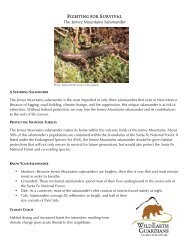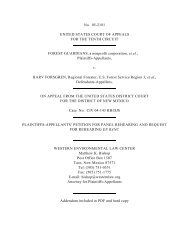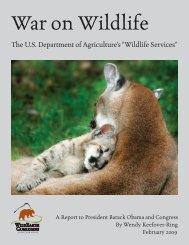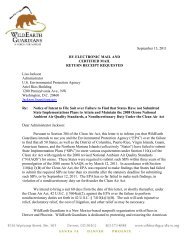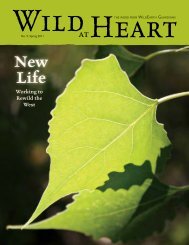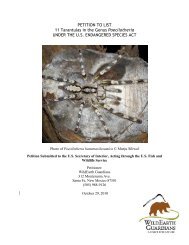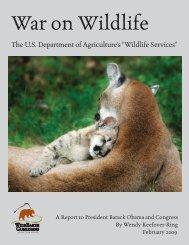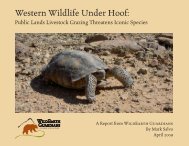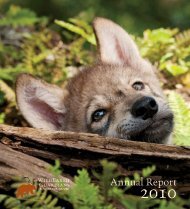here - WildEarth Guardians
here - WildEarth Guardians
here - WildEarth Guardians
You also want an ePaper? Increase the reach of your titles
YUMPU automatically turns print PDFs into web optimized ePapers that Google loves.
photos.com<br />
The Sagebrush Sea<br />
Despite its size, the vast Sagebrush Sea of the<br />
American West is one of North America’s most<br />
endangered landscapes.<br />
“Sagecocks,” now called sage-grouse, are the<br />
most charismatic of all Sagebrush Sea denizens.<br />
First described by Lewis and Clark in 1805,<br />
nineteenth century travelers and settlers reported<br />
huge flocks of sage-grouse that darkened the sky<br />
as they lifted from valley floors. As many as 16<br />
million sage-grouse may have occurred in sagebrush<br />
steppe prior to the arrival of Europeans.<br />
The sage-grouse mating ritual is fascinating<br />
to observe, and often described as among the<br />
most stirring and colorful natural history pageants<br />
in the West. In early spring, at dawn and<br />
often at dusk, males congregate on “leks”—ancestral<br />
strutting grounds to which the birds return<br />
year after year. To attract a hen, males prance, fan<br />
their tail feathers and swell their breasts to reveal<br />
bright yellow air sacs. The combination of wing<br />
movements and inflating and deflating air sacs<br />
make an utterly unique sound: “swish-swishcoo-oopoink!”<br />
Sage-grouse use every part of the Sagebrush<br />
Sea. In the spring, wildflowers provide essential<br />
nutrition to egg-carrying hens. Newly hatched<br />
chicks feed on insects found in the grasses, and<br />
later feed on wildflowers. Sage-grouse summer<br />
range is a combination of sagebrush and<br />
wildflower-rich areas, including wet meadows<br />
and streamsides. Sage-grouse eat only sagebrush<br />
during the winter.<br />
Sage-grouse and pristine sagebrush habitat are<br />
inseparable. Sage-grouse need expanses of healthy<br />
sagebrush habitat – perhaps hundreds of square<br />
miles – with a mosaic of native vegetation and<br />
meandering waterways to survive and flourish.<br />
The physics of beauty is one department of<br />
natural science still in the Dark Ages. Not<br />
even the manipulators of bent space have tried<br />
to solve its equations. Everybody knows, for<br />
example, that the autumn landscape in the<br />
north woods is the land, plus a red maple, plus<br />
a ruffed grouse. In terms of conventional physics,<br />
the grouse represents only a millionth of either<br />
the mass or the energy of an acre. Yet subtract<br />
the grouse and the whole thing is dead.<br />
— Al d o Le o p o l d, 1937<br />
Unfortunately, the loss of sagebrush steppe over<br />
the last 150 years has precipitated steep declines<br />
in sage-grouse populations. Greater sage-grouse<br />
populations have declined by as much as 93<br />
percent from historic levels.<br />
Gunnison sage-grouse, distinct from greater<br />
sage-grouse, now occupy less than ten percent<br />
of their original distribution in the Southwest.<br />
These birds have experienced significant declines<br />
and only about 4,000 breeding individuals<br />
remain. Gunnison sage-grouse may be on the<br />
brink of extinction.<br />
New research predicts further loss of<br />
sagebrush steppe and sage-grouse. Livestock<br />
grazing, gas and oil development, the spread<br />
of weeds and resultant wildfire will continue<br />
to threaten sagebrush habitat and species. New<br />
challenges posed by climate change, wind energy<br />
louis swift<br />
Why Are YOU<br />
a Guardian?<br />
The Sagebrush Sea<br />
reveals Earth’s naked<br />
splendor as now<strong>here</strong><br />
else. To the geologists’<br />
eye, these seeminglybarren<br />
vistas dance<br />
with life and the<br />
vastness of time.<br />
Today, the<br />
Sagebrush Sea’s<br />
vanishing natives are<br />
a telling reminder of<br />
nature’s fragility and<br />
resilience, and of the<br />
planet’s vulnerability<br />
to unceasing<br />
disturbance by<br />
humans. If we cannot<br />
save this extraordinary,<br />
wild landscape, what<br />
hope is t<strong>here</strong> for us?<br />
Sincerely,<br />
Ellen Morris Bi s h op<br />
Oregon Paleo Lands<br />
Institute<br />
Sign up to be a<br />
Sagebrush Sea<br />
Guardian:<br />
wildearthguardians.org<br />
Left to right:<br />
greater sage-grouse,<br />
Gunnison sage-grouse<br />
9



